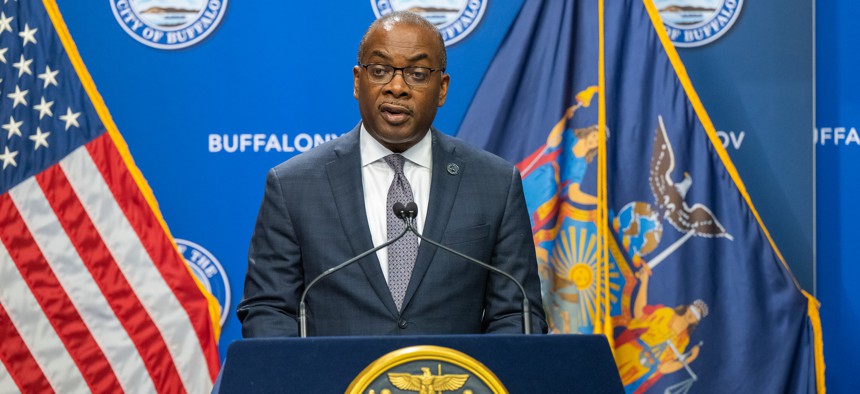Upstate
Upstate mayors highlight flat payments to cities on ‘Tin Cup Day’
They asked for Aid and Incentives for Municipalities to be indexed to inflation so that they can continue to revitalize their cities.

Buffalo Mayor Byron Brown and the rest of New York’s big city mayors advocated for their needs in Albany. Darren McGee/Office of Gov. Kathy Hochul
Local leaders from across New York came to Albany for “Tin Cup Day” on Tuesday to tell state lawmakers what their cities need. Albany Mayor Kathy Sheehan, Buffalo Mayor Byron Brown, Rochester Mayor Malik Evans, Syracuse Mayor Ben Walsh and Yonkers Mayor Mike Spano said they needed more money via Aid and Incentives for Municipalities, reworked county tax shares and revisited payment-in-lieu-of-taxes agreements. The collection of city leaders, testifying jointly, were left hoping lawmakers listened to them at a budget hearing on local government and would aid their efforts to revitalize their cities.
Their main focus though was AIM, a form of state aid that flows to municipalities throughout New York. First created in 2006, the program has seen changes over the years, like what municipalities are included in it and how much money they receive, but in the previous budget, the state doled out a total of $647 million to cities. Now the mayors of some of New York’s latest cities, many of which rely on it for the bulk of their funding, are asking for AIM to be adjusted for inflation in the hopes of securing the financial future of their communities.
“As we institute new local measures to achieve fiscal sustainability, I also must address the negative impact of the state’s 15-year freeze on AIM, New York state Aid and Incentives to Municipalities,” Walsh said in his written testimony. “AIM is the second largest source of revenue for the city of Syracuse. Flat AIM is a major contributor to our fiscal plight.”
Inflationary concerns within local government are nothing new, but the size of the gap between how much cities receive in AIM and what they could be getting was sizable based on Sheehan’s projections. She said that if it had been tied to inflation, AIM would be 32% higher than it is now.
“We understand that you have difficult decisions to make and lots of things that need to be funded, but I think that’s why we’ve been bashful,” she added.
Brown, on the other hand, was seeking not just an increase in AIM but a reworking of the sales tax sharing agreement between Buffalo and Erie County. He said due to a 1985 financial crisis, Buffalo agreed to increase sales tax by 1%. He said in his written testimony Buffalo missed out on at least $1.2 billion of revenue between 1986 and 2022. This was because Erie County did not share that additional income under the terms of their original agreement, according to Brown.
He also asked that tax disbursements from hotel and vacation stays be recalculated.
“Visitors come to Buffalo to experience Buffalo, and while the city provides public safety, street maintenance and amenities in the city, we do not benefit from these visitors’ hotel stays or fully from their retail and service purchases,” Brown wrote. “Instead, the county outside the city benefits from this activity. It is time to adjust the split of these taxes to equitably reflect both the city’s efforts and needs.”
Sheehan also had localized asks, requesting in pre-submitted testimony that the Empire State Plaza PILOT and Capital City payment be made permanent. The Empire State Plaza PILOT is slated to expire in 2032 and the Capital City payment is not a permanent fixture in the state’s budget.
Albany is in the peculiar position of having the majority of property within its borders being tax-exempt, much of it owned by the state. According to material submitted by Sheehan’s office, Albany receives $17 million in PILOT fees annually for state-owned property worth $7.3 billion. Sheehan proposed that the two payments be rebased to New York’s property tax cap.
Some mayors expressed concern over school Foundation Aid or funding for emergency services, but the overarching concern throughout was securing more money through AIM. Leaving the hearing chamber, Brown thought they left a good impression.
“I think the lawmakers that were here today in the Senate and the Assembly were very receptive. They asked a lot of questions; they seemed very responsive to the ‘Big Five’ mayors,” Brown said.

